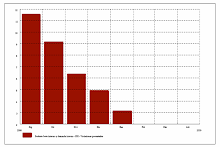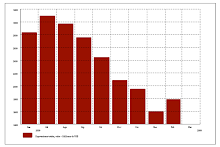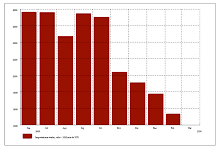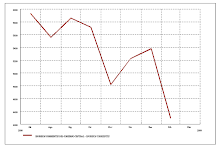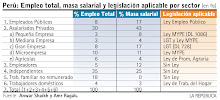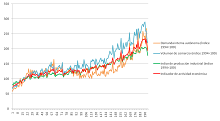http://money.cnn.com/news/storysupplement/economy/bank_failures/index.htm
17. TASAS DE INTERES Peru
16. tipo de cambio sol/dolar-consulta del dia
V. SECCION: M. PRIMAS
1. SECCION:materias primas en linea:precios
![[Most Recent Quotes from www.kitco.com]](http://www.weblinks247.com/indexes/gfms.gif) |
METALES A 30 DIAS click sobre la imagen
(click sur l´image)
2. PRECIOS MATERIAS PRIMAS
9. prix du petrole
10. PRIX essence
petrole on line
Find out how to invest in energy stocks at EnergyAndCapital.com.
31 ago 2010
30 ago 2010
situación del sistema bancario europeo
|
de la lista Macroperu, Indicadores Educación Perú inei
enviado a la lista macroperu, se los paso, saludos,g
ingresos y consumo en China
| Have we underestimated Chinese consumption? Posted: 28 Aug 2010 05:00 AM PDT By Michael PettisOn August 8 Credit Suisse published a study they had commissioned by Professor Wang Xiaolu of the China Reform Foundation. A lot of readers have asked on- and offline me to discuss this study in light of the entry I posted two weeks ago about Chinese consumption – and especially to explain whether this study would cause me to retract any of the things I said. Before I get into that, I suppose by now everyone has noticed that China is trying to diversify its reserve holdings and is reported to be buying more Japanese yen and Korean won, and perhaps other currencies. In my entry six weeks ago, I argued that the fear that China could disrupt the US Treasury market by dumping dollars was totally unreasonable. The latest news supports my argument, I think. First, it is pretty clear from the recent performance of the market that the vigorous attempt to diversify PBoC holdings has had no disruptive affect on the US Treasury market. It cannot. The world has a problem of too many countries eager to increase their export of savings and too few increasingly reluctant countries importing savings. Too-little foreign financing won't be an issue for the US Treasury, it is too much foreign financing that the US must worry about. As if to prove the point, the Financial Times had an article Wednesday with the title: "Foreigners flock to buy US Treasuries." I am pretty sure they will continue "flocking" for many more years.Second, even the small moves into won and yen are causing consternation in Japan and Korea. For example, Saturday's Financial Times has this: Japanese prime minister Naoto Kan on Friday said he was ready to take "decisive" action on the yen, and urged the Bank of Japan to implement "expeditious" monetary policy measures.I pointed out in my piece six weeks ago that if the PBoC switches from dollars to some other currency, one of two things must happen. Either the recipient country buys dollars to keep its currency from surging, in which case the US gets the money anyway, or the US trade deficit will be transferred to the recipient country, which will cause trade tensions with China. Wednesday's South China Morning Post already has the Japanese financial authorities threatening intervention because the rising yen is hurting exports — although apparently it is not just PBoC buying that is forcing up the yen.The second of those two things is happening, in other words, and to prevent it from continuing, Japan will resort to the first. As an aide, it was not that long ago when the Japanese were arguing that US attempts to force up the yen were misguided because Japan's trade surplus had nothing to do with the undervalued currency. Now, apparently, it seems that the value of the currency does matter after all. Expect a lot more of this. As the US deficit surges as a consequence of the combination of collapsing trade deficits in Europe and expansionary trade-related policies in China, Germany, Japan and other trade surplus countries, surplus countries may implicitly or explicitly try to relieve pressure on the US by forcing deficits onto their neighbors, but no one wants them. In the 1930s this was called beggar-thy-neighbor. I discuss it in an OpEd piece for the Financial Times on Monday. Chinese income is higher than we thought But enough on the awfully gloomy subject of trade. To get back to the Credit Suisse study, it is a very interesting attempt to estimate the real size of the Chinese economy, Chinese household income, and Chinese savings and consumption rates by eliminating some of the biases in the NBS surveys. As they explain it: The purpose is to try to correct the understatement of income in the official household survey by the National Bureau of Statistics (NBS). Basically, the study assumes that while respondents understate their income during the survey of NBS (for reasons like worrying that such information will be passed to tax authorities, etc.), they have no incentive to understate total spending, particularly the percentage of food consumption to total spending (the Engel's coefficient).While I agree that having strangers ask questions about income may introduce biases in people's response – we're probably more likely to understate our income, especially if it includes grey or illegal income, when asked by strangers representing the government – I am not sure how comfortable I am with the idea that having friends ask the same questions eliminates biases. Maybe it just creates a different bias – I suspect we are likely to overstate our income when we discuss it with friends. Still, that aside, the numbers seem plausible, at least to me, but not everyone agrees. According to an article in the the China Daily: Officials from the National Bureau of Statistics (NBS) said on Wednesday that the figures in the report, which was published by an independent group in July, were unreliable.At any rate according to the study there is enough hidden and grey income in China, more than estimated by the NBS, that China's real GDP might be understated by 10% relative to official numbers. In 2008, China's official GDP was RMB 31.4 trillion. According to Wang it really was RMB 34.6 trillion. Chinese household income, the study claims, has also been understated and, with it, Chinese household consumption. The study argues that Chinese household income was about 30% higher than the estimates of the NBS.The response of most analysts and the press to the report was a little puzzling to me. Professor Wang's study, many people seemed to argue, proved that either China didn't have an under-consumption problem, or else it proved that the problem was much less serious than the worriers had claimed because both consumption and income may be higher than we think. A more sophisticated variant was the claim that the study proved that China had much greater potential for consumption growth than previously imagined. Under-consumption is easy to prove The first two statements are simply wrong. They confuse absolute consumption with relative consumption. To say that the Chinese under-consume does not mean not that Chinese households have failed to consume at a certain nominal level. It means that the consumption share of total production is very low. In that sense China most certainly has a serious under-consumption problem, and Professor Wang's study actually suggests that it is worse than any of us has imagined.The third statement is probably true, but only to the extent that the worse the under-consumption problem, the more potential there is for consumption growth. This may be arithmetically correct, but it also suggests that unlocking that consumer potential is likely to be harder than expected. How do we know that China has an under-consumption problem? To answer that question it is unnecessary even to look at the consumption statistics. All you need to know is that China has a very high investment rate (perhaps the highest in the world) and a huge trade surplus.Every country produces goods and either consumes or invests those goods. This is not quite an accounting identity, but it becomes one if you take into account the trade balance. Why? Because if it produces more than it consumes or invests, it must run a trade surplus. If it produces less, it must run a trade deficit. In other words by definition what ever you produce is equal to what you invest plus what you consume plus or minus the trade balance. China has an extremely high investment rate, perhaps the highest ever recorded for a medium or large economy. Countries with high investment rates should normally run trade deficits, since there is so little left over of their production for them to consume that they must import the balance. This is what happened, for example, to the US during most of the 19th Century.But China has probably the highest trade surplus ever recorded. This means that an extraordinarily large portion of its production is invested, and another extraordinarily large portion is exported. So what about consumption? The only way a country can run an extraordinarily high investment rate and an extraordinarily high trade surplus is if consumption is extraordinarily low. So almost by definition we know that consumption in China is extraordinarily low as a share of its total production. It is unnecessary to check consumption statistics to prove this.In fact official statistics do prove it. They show that Chinese households consumed a little less than 36% of total GDP last year. This is an unprecedented number, much lower than the 65-70% typical of the US and Europe and even far below the 50-55% typical of other low-consuming Asian countries. More income inequality But Professor Wang's study suggested something very worrying. He claims that nearly two-thirds of the missing income belongs to the wealthiest 10%. Most of the rest went to households in the top half of the income scale. Poor people in China were far less likely to have hidden, grey, or illegal income.So, according to Professor Wang, Chinese household income is distributed far more unequally than any of us had suspected. This is worrying enough for reasons of social equity, but what does it have to do with consumption? A lot. It turns out, not surprisingly, that the rich consume a much smaller share of their income than do the poor. For example, according to Professor Wang's numbers, households that earn more than RMB 400 thousand save 63% of their income, while households that earn RMB 75-400 thousand save 51%. At the other extreme households that earn RMB 7-10 thousand save only 9% of their income and households that earn less than that dis-save (by 23%)So while Chinese household income might be significantly higher than we thought, most of that additional income goes to the high-savings rich. The Chinese savings rate, consequently, is also much higher and the Chinese consumption rate much lower than the official numbers suggest. How low? Here the number is a shocker. Credit Suisse estimates that last year Chinese household consumption was just over 31 percent of GDP – although I am not sure even they completely believe this number. Still, it suggests that the real consumption rate may be between 31% (their number) and 36% (the official number). Either number is completely off the charts.So isn't this good news for consumption as far as its implications foe the economic imbalances? Consumption is so low that it has no choice but to surge, right? Perhaps, but I am very uncomfortable with this argument. It seems to me that the only way consumption can be so low is if there are some very severe structural impediments that distort consumption growth, and I think there is no reason simply to assume or hope that these impediments will dissolve and, as they do, consumption will explode. Rather than proclaim that Professor Wang's adjusted consumption rate is more evidence that consumption must surge, it seems more reasonable to wonder how any country can have such a massive imbalance. And how can Beijing unwind this imbalance? |
Etiquetas: 2010, chimerica, CHINA, CONSUMO, INTERNACIONAL
Bernanke sobre la deflación USA
Ben Bernanke prepara nuevo vuelo en helicóptero para evitar la deflación
Marco Antonio Moreno 27 de agosto de 2010

Aunque se nos hizo creer que la inflación era el mayor de todos los males, el verdadero peligro está en la deflación, tema al cual hemos dedicado varios artículos. Pues bien, para evitar la ola deflacionaria que viene, la Reserva Federal de Estados Unidos prepara una nueva batería de recursos y estímulos que buscan impedir a toda costa el hundimiento total de la economía de ese país.
Uno de los datos más reveladores lo da la fuerte caída en el consumo de Estados Unidos (ver gráfica), una caída histórica y acorde a la caída general de las bolsas en los últimos meses, incapaces de repuntar. Gran parte de esto es producto del masivo desempleo que, en términos reales supera el 16,5% (aunque el oficial está en el 9,5%). La nueva operación de rescate masivo que programa Ben Bernanke, no es otra cosa que volver a "tirar la plata en helicópeto", tal como lo hizo hace dos años tras el colapso de Lehman Brothers, y cuyos objetivos los describimos en Rescatando al capitalismo en helicóptero. La imprenta y el helicóptero son las dos armas estratégicas con las que los gestores del actual modelo económico-monetarista piensan superar la crisis. ¿Será posible?
A medida que la recuperación económica muestra signos de pulverización caótica, todos las medidas de la Reserva Federal han demostrado ser inútiles porque no atacan el problema de fondo: la creación de empleo. Hasta Paul Krugman se ha quejado hoy de esta falencia que hemos señalado en varios artículos como en El problema no es la deuda sino el desempleo. Sin creación de empleo no hay consumo, y sin consumo ni siquiera se pueden pagar los intereses de la deuda.
En estos dos años, la Fed ha comprado casi dos billones de dólares (el 14% del PIB) entre hipotecas basura y bonos del Tesoro. Pero el dinero no ha fluido hacia la economía real y sólo ha permitido a los bancos limpiar sus deprimidos balances. La llamada flexiblización cuantitativa ha tenido además un impacto negativo en la distribución de la riqueza. El Coeficiente de Gini para los Estados Unidos ha aumentado del 0,40 al 0,45, demostrando la ampliación de la brecha entre ricos y pobres, lo que constituye un fenómeno indeseable para una economía avanzada.
Esta vez, la fijación para los exégetas del modelo económico es frenar la caída de los precios, tal como lucharon contra su elevación. El problema es que los costos de controlar la inflación resultaron excesivos y fueron los que desataron el problema del desempleo masivo. Emplear la misma medicina para aliviar el problema no solo es contraproducente sino que no tiene sentido en la dinámica actual de la globalización. Porque más que aplicar medidas monetaristas lo que se requiere es una política global para enfrentar el futuro que viene con un énfasis en las energías sustentables. Si se adoptara una sola estrategia en esta dirección, el empleo comenzaría a fluir y se aliviaría uno de los mayores dramas actuales. Pero esto no figura en el helicóptero de Bernanke.
__._,_.___
.
__,_._,___
Suscribirse a:
Entradas (Atom)
ENTREVISTAS TV CRISIS GLOBAL
NR.: Director, no presidente
----------------------------------------------
Bruno Seminario 1
-------------------------
Bruno Seminario 2
--------------------
FELIX JIMENEZ 1
FELIZ JIMENEZ 2
FELIX JIMENEZ 3, 28 MAYO
OSCAR DANCOURT,ex presidente BCR
-------------------
Waldo Mendoza, Decano PUCP economia
----------------------
Ingeniero Rafael Vasquez, parlamentario
24 set
recordando la crisis, ver entrevista en diario
Etiquetas
- 1 MAYO
- 2
- 2002
- 2007
- 2008
- 2009
- 2010
- 2011
- 2012
- 2013
- 2014
- 2015
- 2016
- 2o11
- 2OO9
- a
- abr2015
- abril09
- abril10
- acc
- actualidadecono
- AFP
- AFPS
- AFRICA
- Ago11
- AGOS
- AGOST10
- agost12
- AGOSTO2008
- AGOSTO2009
- agosto2015
- AGRO
- AGROEXPORTACION
- AIG
- AL
- ALAGROEXPORTACION
- ALEMANIA
- ALIMENTOS
- amazonia
- AMERICALATINA
- ANDAHUAYLAS
- APEC
- ARCH MES
- ARGENTINA
- asarco
- ASIA
- ATTAC
- australia
- AUTOMOVIL
- AVAAZ
- b
- BAILOUT
- baltic
- BANCOS
- BC
- BCE
- BCRP
- benassy
- benedetti
- BERNANKE
- bernis
- BIELORUSIA
- BIS
- blanchard
- BOE
- BOJ
- BOLIVIA
- BOLSA
- BONUS
- BRASIL
- BRIC
- BUBBLE
- bundesbank
- C
- c rec
- CAFE
- CAMBIOCLIMATICO
- CAMERICAS
- CAN
- CANADA
- CANCION
- CAPITALISMO
- castro
- CDO
- cepij
- CHAVEZ
- cheque
- CHILE
- chimerica
- CHINA
- CHRYSLER
- CICLO
- CIE
- ciencia
- CIP
- COBRE
- COLOMBIA
- COMERCIO
- commodities
- COMPUTO
- CONSTRUCCION
- CONSUMO
- CONTAGIO
- control
- COPENHAGUE
- CORRUPCION
- coursera
- CRECIMIENTO
- CREDITO
- CRISIS
- CUBA
- CUMBREALCUE
- CUMBREALCUSA
- davos
- DEC08
- DEC11
- dec12
- DEC13
- dec15
- DEFICIT
- DEFLACION
- demanda
- DEPRESION
- DERIVADOS
- DEUDA
- developpement
- DIC09
- DIC10
- dic12
- DICIEMBRE
- do
- DOLAR
- doubledip
- dsk
- dubai
- duracion
- ec
- ecologo
- ECONOMIA
- ECUADOR
- EDUCA
- efectos
- EMPLEO
- EN11
- en16
- EN2016
- encuesta
- ene016
- energia
- ENERO
- ENERO09
- enero10
- EST
- eu
- EURO
- expansion
- EXPORTACION
- f
- fannie
- feb09
- feb10
- feb13
- feb15
- FED
- filo
- fin
- FINANZAS
- FINLANDIA
- fisica
- flu
- FMI
- FONDOS
- fr
- FRANCE
- frankfurt
- frontrunning
- fukushima
- G20
- G7
- GAS
- geab
- GEITHNER
- gini
- GLO
- global
- GM
- GONZALO GARCIA
- grece
- GREENSPAN
- GRENOBLE
- gripeporcina
- grupo mexico
- HAITI
- hambre
- HEDGE FUNDS
- HIPOTECA
- hist
- HOLLANDE
- HONDURAS
- IMPORTACION
- IMPUESTOS
- INDE
- INDIGNADOS
- INDUSTRIAL
- INFLACION
- INFORMALIDAD
- INFRAESTRUCTURA
- INGENIERIA
- INGENIEROS
- innova
- INTEGRACION
- INTERNACIONAL
- INVERSION
- IRAN
- IRLANDA
- ISLANDIA
- ismea
- ITALIA
- IZQ
- JAPON
- JUL11
- JULIO08
- JULIO09
- JULIO15
- JUN09
- jun10
- jun11
- JUN12
- jun13
- jun15
- JUNIO08
- keynes
- KRUGMAN
- lagarde
- LAREPUBLICA
- leap
- leverage
- liquidez
- LITIO
- lme
- LR
- macro
- MACROECONOMICS
- madera
- MADOFF
- MAMBIENTE
- MANGO
- MARS09
- mars10
- marx
- matematicas
- MATERIASPRIMAS
- MATUK
- MAY09
- MAY11
- MAY12
- MAY13
- may15
- may2015
- MAYO
- MBS
- me
- mef
- MERKEL
- METALES
- MEXICO
- miga
- MIGRA
- MINERIA
- MODELES
- MONDE
- MONEDA
- mourey
- MUJICA
- MUNDO
- musica clasica
- NACIONALIZACION
- neural
- niño
- nobel
- NOTASEMANAL
- NOV08
- nov09
- nov10
- NOV11
- NOV12
- nov15
- nuclear
- OBAMA
- OCDE
- oct09
- oct10
- OCT11
- oct12
- OCTUBRE08
- OFCE
- OIT
- OMC
- ORO
- paita
- PANAMA
- PAPA
- PARADIS
- PARAGUAY
- PAULSON
- pbi
- pe
- PEÑAFLOR
- PERU
- pesca
- PETROLEO
- piketty
- PLAN
- PMI
- POBLA
- POBREZA
- POL
- POLITICA
- porter
- portugal
- postcrisis
- PPT_CRISIS
- PRODUCCION
- PRODUCTIVIDAD
- profits
- prog
- PROTECCION
- QUIEBRA
- r
- RECESION
- REGULACION
- REMESAS
- REPEC
- REPRISE
- REPSOL
- RESERVAS
- RETAIL
- RGE
- RIESGOPAIS
- RMBS
- ROBOTICA
- RODRIK
- ROUBINI
- RUSIA
- SALARIOS
- SARKO
- school paris
- sep11
- SEP15
- SEQUIA
- SERVICIOS
- set09
- set10
- set11
- set12
- SET15
- SETIEMBRE08
- SINGAPUR
- SIRIA
- sismo
- soros
- southern
- SPAIN
- STANFORD
- STIGLITZ
- SUBPRIMES
- SUISSE
- SYRIZA
- TAIWAN
- TARIFAS
- TAS
- TCAMBIO
- TECNOLOGIA
- TERRITORIO
- TEXTIL
- TINTERES
- TLC
- TPP
- trabajo
- trentin
- TRICHET
- TROIKA
- tsunami
- TURISMO
- TV
- UBS
- UE
- UK
- UKRANIA
- UNASUR
- URUGUAY
- USA
- v
- VENEZUELA
- VIDEO
- vivienda
- WALL STREET
- WS
- wsj
- YEN
- young
- YUAN
- Zbasura
- zerohedge
Peru:crisis impacto regional arequipa,raul mauro
Temas CRISIS FINANCIERA GLOBAL
QUIEN SOY?
claves para pensar la crisis
-Tipo de cambio
- DIARIOS DE HOYNLACES
claves para pensar la crisis
MATERIAS PRIMAS
-Metales
-Cobre
- plata
- oro
- zinc
- plomo
- niquel
- petroleo
-Tipo de cambio
- LA CRISIS
- BOLSA VALORES
- BANCOS
- PBI PAISES
- USA: DEFICIT GEMELOS
- UE: RIEN NE VA PLUS
CONTAGIO: CANALES
- PERU: DIAGRAMA DE CONTAGIO
- PERU: IMPACTO EN BOLSA
- MEXICO: HAY CRISIS?
LA PRENSA
COMENTARIO DE HOY
- DIARIOS DE HOY
Coyuntura
Bancos centrales
Paginas Recomendadas
BLOGS
economiques
Interes
VIDEO
- Economia videos
- Crisis financiera global
TRICONTINENTAL
- AFRICA: daniel
- EUROPA: helene
- ASIA:
- AMERICA
COLUMNAS AMIGAS
Chachi Sanseviero
ETIQUETAS
por frecuencia de temas
por alfabetico
EVENTOS
FOTOS DEL PERU
GONZALO EN LA RED
JOBS
VOZ ME CONVERTIDOR
CLIMA
SUDOKU
PICADURAS
LOGO
LIBRO de GONZALO
La exclusion en el Peru
-Presentacion
- introduccion
- contexo economico
- crisis de la politica
- excluidos de las urbes
- excluidos andinos
- contratapa
VIDEOS ECONOMICOS
Crisis Enero 2009
Krugman
Globalizacion 1
Globalizacion 2
Crisis Brasil
Crisis bancaire
Karl marx revient
TODOS LOS DERECHOS RESERVADOS
GOOGLE INFORMA
PRESS CLIPPINGS-RECORTES PRENSA-PRESSE..
PRESS CLIPPINGS-RECORTES PRENSA-PRESSE..
canciones de GRACIAS A LA VIDA !
ETIQUETAS alfabetico
- 1 MAYO
- 2
- 2002
- 2007
- 2008
- 2009
- 2010
- 2011
- 2012
- 2013
- 2014
- 2015
- 2016
- 2o11
- 2OO9
- a
- abr2015
- abril09
- abril10
- acc
- actualidadecono
- AFP
- AFPS
- AFRICA
- Ago11
- AGOS
- AGOST10
- agost12
- AGOSTO2008
- AGOSTO2009
- agosto2015
- AGRO
- AGROEXPORTACION
- AIG
- AL
- ALAGROEXPORTACION
- ALEMANIA
- ALIMENTOS
- amazonia
- AMERICALATINA
- ANDAHUAYLAS
- APEC
- ARCH MES
- ARGENTINA
- asarco
- ASIA
- ATTAC
- australia
- AUTOMOVIL
- AVAAZ
- b
- BAILOUT
- baltic
- BANCOS
- BC
- BCE
- BCRP
- benassy
- benedetti
- BERNANKE
- bernis
- BIELORUSIA
- BIS
- blanchard
- BOE
- BOJ
- BOLIVIA
- BOLSA
- BONUS
- BRASIL
- BRIC
- BUBBLE
- bundesbank
- C
- c rec
- CAFE
- CAMBIOCLIMATICO
- CAMERICAS
- CAN
- CANADA
- CANCION
- CAPITALISMO
- castro
- CDO
- cepij
- CHAVEZ
- cheque
- CHILE
- chimerica
- CHINA
- CHRYSLER
- CICLO
- CIE
- ciencia
- CIP
- COBRE
- COLOMBIA
- COMERCIO
- commodities
- COMPUTO
- CONSTRUCCION
- CONSUMO
- CONTAGIO
- control
- COPENHAGUE
- CORRUPCION
- coursera
- CRECIMIENTO
- CREDITO
- CRISIS
- CUBA
- CUMBREALCUE
- CUMBREALCUSA
- davos
- DEC08
- DEC11
- dec12
- DEC13
- dec15
- DEFICIT
- DEFLACION
- demanda
- DEPRESION
- DERIVADOS
- DEUDA
- developpement
- DIC09
- DIC10
- dic12
- DICIEMBRE
- do
- DOLAR
- doubledip
- dsk
- dubai
- duracion
- ec
- ecologo
- ECONOMIA
- ECUADOR
- EDUCA
- efectos
- EMPLEO
- EN11
- en16
- EN2016
- encuesta
- ene016
- energia
- ENERO
- ENERO09
- enero10
- EST
- eu
- EURO
- expansion
- EXPORTACION
- f
- fannie
- feb09
- feb10
- feb13
- feb15
- FED
- filo
- fin
- FINANZAS
- FINLANDIA
- fisica
- flu
- FMI
- FONDOS
- fr
- FRANCE
- frankfurt
- frontrunning
- fukushima
- G20
- G7
- GAS
- geab
- GEITHNER
- gini
- GLO
- global
- GM
- GONZALO GARCIA
- grece
- GREENSPAN
- GRENOBLE
- gripeporcina
- grupo mexico
- HAITI
- hambre
- HEDGE FUNDS
- HIPOTECA
- hist
- HOLLANDE
- HONDURAS
- IMPORTACION
- IMPUESTOS
- INDE
- INDIGNADOS
- INDUSTRIAL
- INFLACION
- INFORMALIDAD
- INFRAESTRUCTURA
- INGENIERIA
- INGENIEROS
- innova
- INTEGRACION
- INTERNACIONAL
- INVERSION
- IRAN
- IRLANDA
- ISLANDIA
- ismea
- ITALIA
- IZQ
- JAPON
- JUL11
- JULIO08
- JULIO09
- JULIO15
- JUN09
- jun10
- jun11
- JUN12
- jun13
- jun15
- JUNIO08
- keynes
- KRUGMAN
- lagarde
- LAREPUBLICA
- leap
- leverage
- liquidez
- LITIO
- lme
- LR
- macro
- MACROECONOMICS
- madera
- MADOFF
- MAMBIENTE
- MANGO
- MARS09
- mars10
- marx
- matematicas
- MATERIASPRIMAS
- MATUK
- MAY09
- MAY11
- MAY12
- MAY13
- may15
- may2015
- MAYO
- MBS
- me
- mef
- MERKEL
- METALES
- MEXICO
- miga
- MIGRA
- MINERIA
- MODELES
- MONDE
- MONEDA
- mourey
- MUJICA
- MUNDO
- musica clasica
- NACIONALIZACION
- neural
- niño
- nobel
- NOTASEMANAL
- NOV08
- nov09
- nov10
- NOV11
- NOV12
- nov15
- nuclear
- OBAMA
- OCDE
- oct09
- oct10
- OCT11
- oct12
- OCTUBRE08
- OFCE
- OIT
- OMC
- ORO
- paita
- PANAMA
- PAPA
- PARADIS
- PARAGUAY
- PAULSON
- pbi
- pe
- PEÑAFLOR
- PERU
- pesca
- PETROLEO
- piketty
- PLAN
- PMI
- POBLA
- POBREZA
- POL
- POLITICA
- porter
- portugal
- postcrisis
- PPT_CRISIS
- PRODUCCION
- PRODUCTIVIDAD
- profits
- prog
- PROTECCION
- QUIEBRA
- r
- RECESION
- REGULACION
- REMESAS
- REPEC
- REPRISE
- REPSOL
- RESERVAS
- RETAIL
- RGE
- RIESGOPAIS
- RMBS
- ROBOTICA
- RODRIK
- ROUBINI
- RUSIA
- SALARIOS
- SARKO
- school paris
- sep11
- SEP15
- SEQUIA
- SERVICIOS
- set09
- set10
- set11
- set12
- SET15
- SETIEMBRE08
- SINGAPUR
- SIRIA
- sismo
- soros
- southern
- SPAIN
- STANFORD
- STIGLITZ
- SUBPRIMES
- SUISSE
- SYRIZA
- TAIWAN
- TARIFAS
- TAS
- TCAMBIO
- TECNOLOGIA
- TERRITORIO
- TEXTIL
- TINTERES
- TLC
- TPP
- trabajo
- trentin
- TRICHET
- TROIKA
- tsunami
- TURISMO
- TV
- UBS
- UE
- UK
- UKRANIA
- UNASUR
- URUGUAY
- USA
- v
- VENEZUELA
- VIDEO
- vivienda
- WALL STREET
- WS
- wsj
- YEN
- young
- YUAN
- Zbasura
- zerohedge
![[Most Recent Quotes from www.kitco.com]](http://www.kitconet.com/charts/metals/base/spot-copper-30d.gif)
![[Most Recent Quotes from www.kitco.com]](http://www.kitconet.com/charts/metals/base/zinc-d.gif)
![[Most Recent Quotes from www.kitco.com]](http://www.kitconet.com/charts/metals/base/lead-d.gif)
![[Most Recent Quotes from www.kitco.com]](http://www.kitconet.com/charts/metals/base/spot-nickel-30d.gif)


























